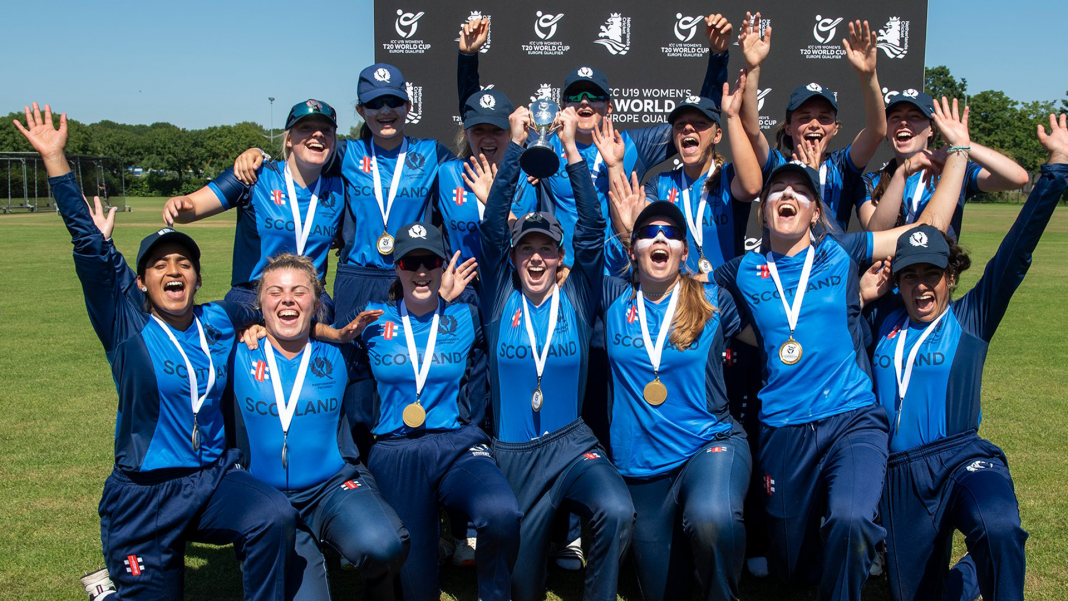This week’s Under-19 Women’s T20 World Cup European qualifier in Utrecht, comprehensively won by Scotland, not only sent a strong Scottish team to next year’s tournament in South Africa; it also provided an instructive guide to the relative position of girls’ and women’s cricket in Scotland and the Netherlands.
As it turned out, the Dutch were most competitive in the opening game, when a disciplined attack restricted Scotland to 135 for six, captain Katherine Fraser making a 30-ball 33 and Molly Barbour-Smith 42 from 29 deliveries.
Kristine Smits conceded just 9 runs in her four overs, while Robyn van Oosterom picked up two for 21 with her left-arm wrist spin and Els Keppel two for 34.
Fraser and Olivia Bell then grabbed three wickets before the hosts had a run on the board, but Phebe Molkenboer’s 18, made before she was forced to retire with a back injury, and a solid 29 from Dutch skipper Merel Dekeling enabled the home side to reach 78, Bell finishing with three for 10 and Nayma Shaikh two for 10.
Batting first in the second match, the Netherlands batted much more effectively, reaching 70 for two, thanks to Van Oosterom’s 40-ball 39 and 20 from Dekeling, the two players in the Dutch side who looked most at home at this level, before battling their way to 94 for seven.
Shaikh picked up another two wickets at a cost of 16 runs, while Barbour-Smith, in her only spell of the series, was distinctly too quick for the Dutch batters and claimed three for 10.
The Scots needed only 8.1 overs to knock off the runs for the loss of Ailsa Lister’s wicket; her 25-ball 44 included eight fours and a six, and Darcey Carter made 30 not out from just 19 deliveries.
Their opening partnership of 67, however, proved to be a mere rehearsal for the final game, in which they shared a stand of 204 before Smits finally achieved a breakthrough; Player of the Series Lister made 111 from 58 deliveries with 16 fours and a six, while Carter finished on 103 not out, from 55 balls with 12 fours and two sixes.
Chasing 223 for two, it was again Van Oosterom and Dekeling who stood out for the Netherlands, Van Oosterom making 43 from 50 deliveries and Dekeling 20 from 23 as the side reached 100 for the first time.
Shaikh brought her tally of wickets for the series to seven, at an average cost of 4.71, while Molly Paton took two for 8.
The superiority of the Scots in all departments of the game was undoubtedly not an accident: it was just reward for the hard work and clearly thought-out development programmes of Nicola Wilson (ironically, as Nicola Payne, herself a Dutch international cricketer) and Rosy Ryan, both domestically and internationally.
Five members of the Scottish squad, Fraser, Lister, Orla Montgomery, Paton and Niamh Robertson-Jack, have extensive experience with the Scottish Under-17 women’s team, playing in the ECB County Cup, while with the exception of three (Barbour-Smith, Bell and Carter) who play their club cricket in England, the rest of the team appear regularly in the Scottish Women’s Premier League.
The opportunities afforded the Dutch women, on the other hand, have been much more restricted, although all have benefited from the Lionesses programme which brings together girls from all clubs with youth programmes for training sessions and for annual tours to England.
The Lionesses did field a team in this year’s domestic women’s T20 competition, winning five of their eight round robin matches and gaining valuable experience against players from the senior national side, and five members of the Under-19 squad did make at least one appearance in the domestic Pro Series, but for many of the side their most regular challenge is for their clubs in the Under-17 youth competition, where they play alongside the boys.
The relatively small numbers of girls playing cricket in the Netherlands have prevented the development of separate girls’ competitions, first recommended as long ago as 2014, and the problem has been compounded this year by the decision to split the women’s 40-over competition into two divisions of four teams: more than half the Under-19 squad play for HBS Craeyenhout, and therefore find themselves in the comparatively undemanding second division.
Once they had established that the Dutch attack was relatively inoccuous and that the batters were, Van Oosterom and Dekeling apart, unlikely to hit many boundaries – the count for the series was 51 fours and three sixes by the Scots, as against 18 fours by the Netherlands — Katherine Fraser’s side were increasingly dominant, and although the Dutch continued to battle hard, it became an ever more unequal struggle.
For the Scots, the next big challenge will be as one of the Associate qualifiers in the T20 World Cup in South Africa next January, while for the Netherlands the task will be as much off the field as on it, creating the domestic structures and development programmes which would ensure that next time a Dutch under-19 women’s side plays in an international tournament it is much better equipped to pass the test.
You’re reading Emerging Cricket — brought to you by a passionate group of volunteers with a vision for cricket to be a truly global sport, and a mission to inspire passion to grow the game.
Be sure to check out our homepage for all the latest news, please subscribe for regular updates, and follow EC on Twitter, Facebook, LinkedIn and YouTube.
Don’t know where to start? Check out our features list, country profiles, and subscribe to our podcast.
Support us from US$2 a month — and get exclusive benefits, by becoming an EC Patron.







